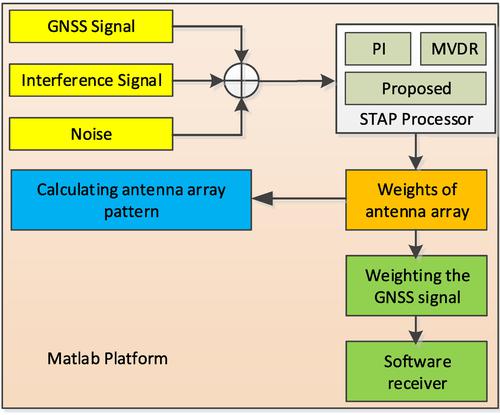当前位置:
X-MOL 学术
›
IET Radar Sonar Navig.
›
论文详情
Our official English website, www.x-mol.net, welcomes your feedback! (Note: you will need to create a separate account there.)
Distortion-less carrier phase tracking space-time adaptive processor based on power inversion criterion for GNSS anti-jamming receiver
IET Radar Sonar and Navigation ( IF 1.7 ) Pub Date : 2023-12-01 , DOI: 10.1049/rsn2.12515 Yaoding Wang 1
IET Radar Sonar and Navigation ( IF 1.7 ) Pub Date : 2023-12-01 , DOI: 10.1049/rsn2.12515 Yaoding Wang 1
Affiliation

|
Space-time adaptive processor (STAP) has been widely used for global navigation satellite system (GNSS) anti-jamming receiver due to its good anti-jamming performance. When direction of satellite is unknown, STAP can be implemented based on power inversion (PI) criterion. However, existing space-time PI algorithm will introduce tens to hundreds of degrees biases into carrier phase, and sometimes will even cause cycle slips, which will reduce the success rate of ambiguity resolution, ultimately deteriorating positioning accuracy. A distortion-less carrier phase tracking space-time PI algorithm is proposed. The main novelty is that the proposed algorithm keeps the coefficients of the temporal taps as real values by imposing constraints on the weights of the antenna array. Several experiments are implemented to verify the effectiveness of the proposed algorithm. For comparison, the results of PI algorithm and minimum variance distortion-less response (MVDR) algorithm are shown. Results show that when the number, style, and direction of interferences and the direction of GNSS signal vary, different degrees of biases are introduced into carrier phases for the PI and the MVDR algorithm. However, no bias is introduced into the proposed algorithm. As a result, the effectiveness of the proposed algorithm is verified.
中文翻译:

基于功率倒置准则的GNSS抗干扰接收机无失真载波相位跟踪空时自适应处理器
空时自适应处理器(STAP)因其良好的抗干扰性能而被广泛应用于全球导航卫星系统(GNSS)抗干扰接收机。当卫星方向未知时,可以基于功率反转(PI)准则来实现STAP。然而,现有的时空PI算法会给载波相位带来数十至数百度的偏差,有时甚至会造成周跳,从而降低模糊度解算的成功率,最终导致定位精度下降。提出了一种无失真载波相位跟踪空时PI算法。主要的新颖之处在于,所提出的算法通过对天线阵列的权重施加约束来将时间抽头的系数保持为真实值。进行了多次实验来验证所提出算法的有效性。为了进行比较,显示了 PI 算法和最小方差无失真响应(MVDR)算法的结果。结果表明,当干扰的数量、类型和方向以及GNSS信号的方向不同时,PI和MVDR算法的载波相位都会引入不同程度的偏差。然而,所提出的算法没有引入偏差。结果验证了所提算法的有效性。
更新日期:2023-12-04
中文翻译:

基于功率倒置准则的GNSS抗干扰接收机无失真载波相位跟踪空时自适应处理器
空时自适应处理器(STAP)因其良好的抗干扰性能而被广泛应用于全球导航卫星系统(GNSS)抗干扰接收机。当卫星方向未知时,可以基于功率反转(PI)准则来实现STAP。然而,现有的时空PI算法会给载波相位带来数十至数百度的偏差,有时甚至会造成周跳,从而降低模糊度解算的成功率,最终导致定位精度下降。提出了一种无失真载波相位跟踪空时PI算法。主要的新颖之处在于,所提出的算法通过对天线阵列的权重施加约束来将时间抽头的系数保持为真实值。进行了多次实验来验证所提出算法的有效性。为了进行比较,显示了 PI 算法和最小方差无失真响应(MVDR)算法的结果。结果表明,当干扰的数量、类型和方向以及GNSS信号的方向不同时,PI和MVDR算法的载波相位都会引入不同程度的偏差。然而,所提出的算法没有引入偏差。结果验证了所提算法的有效性。



























 京公网安备 11010802027423号
京公网安备 11010802027423号